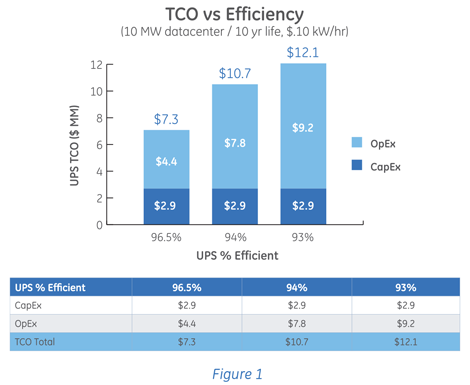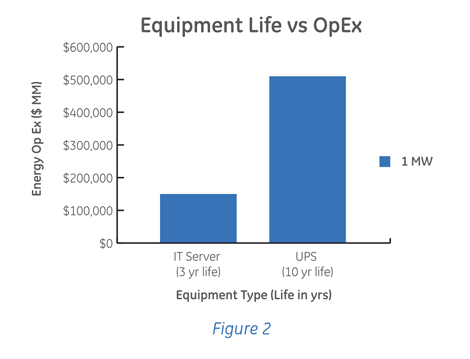Harry Handlin is Director of Critical Power Applications, GE Critical Power. He co-authored this column with Brad Thrash, Product Manager, Global Three-Phase UPS, GE Critical Power. Handlin and Thrash are part of the senior engineering and product management team with GE Critical Power’s AC Power Group, responsible for helping to develop and bring to market energy efficient UPS technology including GE’s new TLE Series UPS with eBoost technology.
Most people in the data center world understand the basic concepts of total cost of ownership (TCO) - the sum of initial capital expenditures (CapEx) added to ongoing and long-term operational expenditures (OpEx). TCO is a critical metric when designing a new data center facility or selecting equipment. Yet, with the explosion of data center expansion -- identifying and weighing the value of TCO variables when specifying, building and operating a data center may be more elusive. A simple miscalculation can cost companies millions of dollars every year.
We know that energy is certainly one of those critical TCO variables, as data centers are significant consumers of energy. Servers and data equipment account for 55 percent of the energy used by a data center, followed by 30 percent for the cooling equipment to keep the facility operational. Even electrical power distribution losses, including uninterruptible power supply (UPS) losses, consume a significant 12 percent of energy consumption. Interestingly, only 3 percent is consumed by lighting.1
Power Equipment Purchases: Why 1 Percent Energy Efficiency Matters
Energy efficiency gains, in any of these areas, have a significant impact on TCO and annual operating expenses, especially on high power, long life assets. For example, let’s look at just a 1 percent efficiency improvement for a UPS deployment at a 10 megawatt (MW) data center. As the chart (Figure 1) below shows, while CapEx is fixed, the OpEx costs of a UPS over 10 years shows an operational savings of $1.4 million with just an energy efficiency improvement of one percent - from 93 to 94 percent. With newer eco-mode or multi-mode UPS technologies that offer up to 96.5 percent efficiency (or higher), that savings jumps to almost $3.4 million. So, applying a TCO model uncovers the impact of how just a single percentage gain in energy efficiency adds ups.
Wrestling with TCO OpEx versus CapEx Demands
So, as mentioned earlier, if TCO models are understood by the data center industry, why aren’t many of the TCO criteria established for a data center’s design applied during the final equipment procurement phases of data center construction or upgrades? Unfortunately, the TCO model is often abandoned when the project phase turns to selecting power system components, such as a UPS, because of short-term CapEx concerns over the initial cost.
While the capital expenditures for UPS systems are relatively the same, the OpEx for UPS energy consumption can easily exceed the CapEx over the life of the equipment due to differences in energy efficiency. Deciding what equipment to buy is analogous to buying a car on price, without considering the price of gasoline, fuel economy and maintenance costs.
This pressure between short-term CapEx purchasing criteria and long-term OpEx TCO evaluations are easy to understand. Decisions for purchasing power systems typically are driven by two groups: (1) the real estate organization or project team with a mandate to reduce capital expenditures to deliver a data center “on time and on budget” and; (2) data center operators responsible for reducing operational expenditures, including energy consumption and maintenance costs over the life of the system.
As stated earlier, CapEx includes the cost of equipment and installation expenses. Often times, equipment efficiency is specified at a minimum level, and the purchasing decision is solely based on meeting the minimum level specified with no evaluation credit given for exceeding the minimum efficiency level. Instead, the purchase price and how it compares to budgeted amounts and the immediate availability of equipment often play a larger role in procurement decisions.
Even when senior management identifies OpEx as a key factor early in the planning of a power system, buying decisions made with the more immediate pressures of component price and availability are often made at the expense of OpEx criteria. When purchasing is outsourced to contractors, a divergence from management’s original intent is even more likely.
Furthering this short-term CapEx versus OpEx vantage is that most of the “hardware” in a data center comprises servers and networking equipment. Typical data center TCO evaluations (Figure 2) for an asset like a server, with a typical life span of two to three years, is a very different calculation than the long-term critical power requirements of a complete data center with a life span of 10 to 15 years.
Savings Realized Through Use of TCO Models
Data center design and operational teams can ultimately realize millions of dollars in savings when applying TCO models to the evaluation and purchasing of components for critical power systems. This is particularly true for energy-intensive equipment, such as UPS systems, where electricity costs can easily exceed their purchase price in only a few years, and where energy efficiency ratings of a few percentage points can add to significant operational cost savings.
To realize the long term benefits and cost savings of a TCO evaluation and purchase model, data center managers have an opportunity to align their CapEx-centric purchasing team with the OpEx goals of their operational teams. TCO can become a common metric for both groups as they work together to create energy efficient data centers that return long-term value.
Endnotes:
1 Uptime Institute – May 2012
Industry Perspectives is a content channel at Data Center Knowledge highlighting thought leadership in the data center arena. See our guidelines and submission process for information on participating. View previously published Industry Perspectives in our Knowledge Library.







